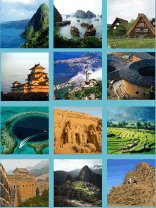Guide 2: Developing a strategy for progressive change
What this guide will tell you:
This guide will tell you how to develop a strategy for your destination that complements both the sensitive nature of a heritage site, as well as the task of sustainable and profitable tourism.
Steps to success:
- Why this matters
-
Destinations are more than just the sum of their parts, and changing the strategy of a destination requires the active support and commitment from a range of stakeholders. There must be an appreciation and anticipation of the domino effect, as certain changes may have unforeseen consequences. With that in mind, there must also be contingency measures in place, as well as a degree of flexibility in the plan chosen.
To secure stakeholder ‘buy-in’ and understanding, it is crucial that there is a destination management strategy for making tourism more sustainable. This realisation is critical to both the success of the plan and the on-going viability of the World Heritage site, itself.
-
 Identify key stakeholders
Identify key stakeholders -
Start by listing the key stakeholders in the destination as a whole – this includes the tourism sector, conservation specialists, community representatives, and other groups or individuals involved in economic, community, environmental management, and heritage protection activities. This need not be an extra expense. All you need is some time and effort, a pen, and a sheet of paper. There is no excuse for not doing this. When you have made your list, you can start a simple mapping analysis of stakeholders' roles, responsibilities, and resources.
Prioritise the list in order to target your resources. While inclusiveness, respect, and listening are the key words in these guides, prioritising your resources is also crucial for strategy development. Some stakeholders will warrant some detailed face-to-face time, others however, can be handled as part of a wider collective forum or consultation.
-
 Listen to different issues, challenges, and aspirations
Listen to different issues, challenges, and aspirations -
Sustainable tourism requires both community and business buy-in and support, so one of the first steps is to exchange ideas with the full range of stakeholders in the community, as well as the economic and conservation sectors. In some cases, this will require one-on-one in-depth interviews, while in others it may be achieved through an existing forum or online consultation.
The purpose of this is to identify the aspirations, concerns, opportunities, challenges, roles, and resources of different stakeholders. This is a crucial step in the process – and cannot be undertaken retrospectively. It will require an investment of some time. However, it does not need to be expensive, and the information you gather will certainly be valuable. Without listening there will be no trust and no buy-in. Constructive ideas will emerge from this process– it is not just a feel good exercise.
-
 Identify key strategic issues and test them with stakeholders
Identify key strategic issues and test them with stakeholders -
Develop a simple SWOT analysis.
- What are the key stakeholder concerns?
- The key risks or threats?
- What are the key aspirations for individual businesses/stakeholders/the destination as a whole?
- What are the most threatening risks?
- What are the opportunities for doing things better?
Capture these in a short paper for discussion with stakeholders. The key to this exercise is to identify those key issues that stakeholders will need to focus their efforts, as well as identify other outcomes that might also be achieved. The best strategies are not only about delivering what is good for conservation, but also what is good for communities and businesses.
Organize a public meeting or Destination Management Planning (DMP) forum to explain the emerging strategic focus. In a best case scenario, many people will attend and offer constructive input. Yet, even if attendance is modest and there is some negative feedback, it is still a crucial step in widening understanding, allowing opportunities for feedback, as well as transparency and accountability.
Use the DMP Forum to agree on basic priorities for sustainable tourism in the destination. Different cultures and societies have different ways of reaching a consensus – so there is no one-size-fits-all method for this. The basic reality is that the destination needs management, it has finite resources, and it should focus on some, rather than all, the potential activities at once.
-
 Get support to develop a strategy for the destination
Get support to develop a strategy for the destination -
At the public meetings and discussions with key stakeholders, ask for a mandate supporting strategy development that addresses key issues. Stakeholders must commit to the process of developing a strategy. If not, it is possible they will ignore the destination strategy, or dispute its validity later in the process.
-
 Develop a sustainable, multi-year tourism strategy
Develop a sustainable, multi-year tourism strategy -
Create a simple strategy from what you now know. The DMP forum should have resulted in some degree of consensus on the key issues – this needs to be captured and distributed to ensure that it is widely recognised and respected. It will also allow other stakeholders who did not attend the forum to understand the process that has been initiated.
Strategies may range from hundreds of pages created by specialist teams at a significant cost, to relatively simple documents that can be created for little or no cost. Both options can work depending on your situation and your resources. If you have no existing strategy, even developing a simple one is a step forward and worth doing. The more concise a document is, the more likely people are to read it!
Your strategy should provide the ‘who’, ‘what’, ‘when’, ‘why’, and ‘how’ to bring about the changes desired. It should be built around the core issues identified from both your research on impacts and opportunities (Guide One) and from your stakeholder consultation. The strategy should have a simple vision that reflects the aspirations of the stakeholders. This should, ideally, be partly about protecting the things that matter in your destination, as well as making it better for people to visit, more effectively delivering outcomes desired by the host community and businesses.
Look to connect stakeholder aspirations and site preservation by creating business or community opportunities – stress the positive. The strategy should identify:
- The top 3-5 issues affecting the site
- The opportunities for doing things better
- Explain the current capacity and potential resources for solutions
- Set out the steps required for delivering those future solutions.
A good strategy is quite direct in setting out the issues, risks, challenges, objectives, roles, and responsibilities. It should consider environmental, economic, social, cultural, quality, health and safety, aesthetic, and tourism issues. Everyone in the destination with a role to play should be able to understand what is expected of them when they read it, and how they might benefit from supporting it. You might find it helpful to summarize the strategy in ten simple steps.
The strategy development should also include some careful thinking about future scenarios and look at the costs and benefits of pursuing different objectives – for instance, whether an objective is likely to have economic, ecological, or cultural impacts that are undesirable, or whether the infrastructure required for an objective is genuinely feasible and sustainable.
In the case of a crisis or emergency, as a destination you must develop crisis and emergency management plans for the protection of heritage, local people, individuals in the tourism sector, and visitors. This can mitigate risk if an emergency situation should arise, such as natural disasters, outbreak of social unrest, or other eventualities that might result in large scale damage to the World Heritage site or destination as a whole.
-
 Publish and champion the strategy
Publish and champion the strategy -
You need to sell the strategy and the benefits of supporting it. You need to be able to convince different stakeholders that championing this strategy, and playing an active role in its implementation, will result in desirable outcomes and benefits both for the destination as a whole, and the businesses and communities within it. If the strategy is an effective marriage of socio-economic and conservation perspectives, then it should offer people hope for the future and a road map as to how their aspirations can be realised.
You should also seek to embed the strategy in governing policy. Even if all stakeholders cannot agree, they will need to see the basis on which strategic decisions have been made, have the ability to offer their input, and also understand that some preservation issues at a World Heritage site are effectively non-negotiable. It should also be clear that the process is transparent and accountable.
Put your name on it – great strategies belong to someone. In some of the best cases, the mayor of a destination has published their ownership of a strategy and made it quite clear that it is their job to make it a reality. This really does matter. By taking ownership, people see commitment, and ideally, a commitment leading to success.
Presentation matters (a lot). There are no rules on presentation, but it must communicate the key messages and inspire action. We would encourage you to innovate in terms of finding a way to present your strategy. For example, it does not have to be a dull word document. It might just as easily be a short film, presentation, speech, cartoon, poster for noticeboards, or some other form of communication. Too many strategies fail due to lack of involvement and poor communication, so think carefully about presenting your strategy in a way that will be noticed, understood, and respected by the target audiences. After all, the more accessible your campaign, the greater the chance of widening its ownership.
-
 Identify the agency (or agencies) that will take responsibility for different elements of the strategy
Identify the agency (or agencies) that will take responsibility for different elements of the strategy -
Well-managed World Heritage sites and great tourism destinations are defined by strong leadership, effective partner collaboration, and good governance. Arguably the single biggest determinant of effective sustainable tourism is whether it has a robust and accountable management structure, with the capacity to bring about progressive changes when needed.
We would not presume to offer a one-size-fits-all mode for managing a destination sustainably. World Heritage sites are simply too diverse in terms of their social, cultural, political, and economic contexts. The key is having an organization or partnership with the capacity, knowledge, skills, and commitment to bring about positive changes to the destination. Some destinations will already have fit-for-purpose management organizations or partnership structures; others will need to create them. Either way, there will be a need for leadership and making tough decisions – great management of destinations frequently involves saying ‘no’ more often than saying ‘yes’. It is an essential ingredient of strategic planning that a governance mechanism or partnership is established that can muster the support, resources, and ultimately, the power to deliver any strategy.
-
 Encourage debate and feedback
Encourage debate and feedback -
Publish the strategy to the widest possible audience of stakeholders. It may be easier to develop a strategy behind closed doors with a handful of experts, but however tempting this approach may be, it is a recipe for ineffectiveness. You need to be courageous and involve business, community, and tourism stakeholders in the strategy process at the earliest opportunity. They have valuable perspectives and will be critical to the delivery of any future changes. If you do not involve people at the beginning, they will not believe you later when you tell them you want an inclusive and open process for their benefit.
Even when some stakeholders dissent, look for ways to secure their support. Not everyone will agree with the sustainable tourism strategy in the beginning. This is quite normal. Many successful destinations began the process with some dissenters, but carefully cultivated their interest and support as the plan developed. Keep communicating with them, particularly about how their interests are being addressed, their part in shaping measures, and ultimately how the measures are benefiting them. People are often suspicious of change – the key is good on-going communication, listening, and respect of others’ views.
-
 Reassess the strategy periodically
Reassess the strategy periodically -
A strategy should be regarded as a working document that can be returned to periodically to reflect changes in the destination, its tourism economy, conservation status, and the needs of its community. It is crucial that the strategy is subjected to on-going scrutiny concerning its effectiveness, as well as assessment of whether partners are prioritising time, money, and people to the best effect for achieving the strategy objectives. At least once a year stakeholders should compare progress with the objectives of the strategy and feed in new evidence on the issues.
Future proofing is critical. Tourism has to evolve as the community develops to ensure it continues to offer high quality opportunities. Being aware of this and having flexibility in strategy and governance is extremely important to tourism development.
There is no end to a strategy. It is always a work in progress, constantly evolving to reflect the challenges faced by the destination.



